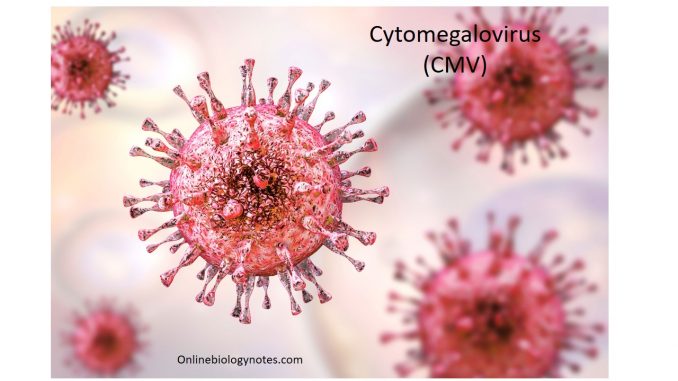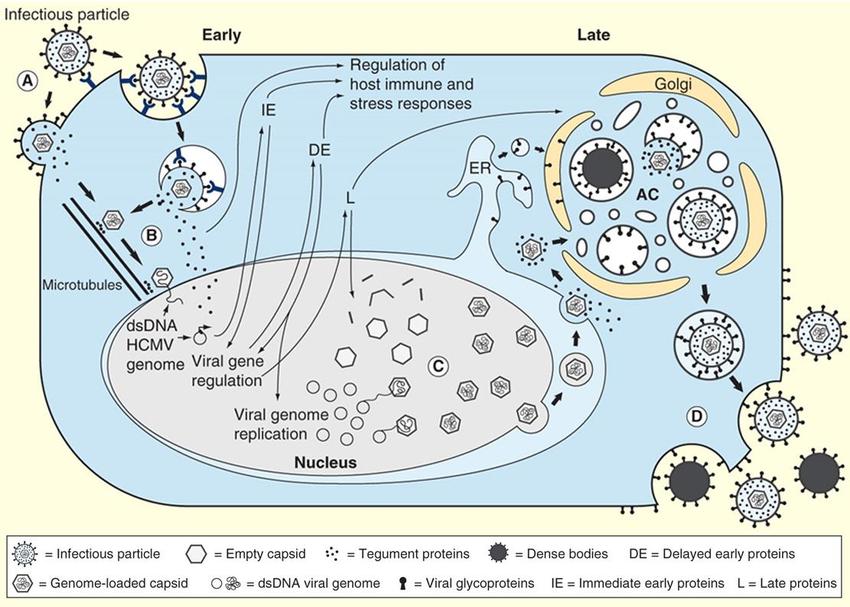
Cytomegalovirus:
- Cytomegalovirus (CMV) is a genus of viruses belonging to the order Herpesvirales, in the family Herpesviridae.
- CMV is the largest member of the human herpes virus family.Its natural host is human and monkeys.
- There is little genetic homology between human CMV and CMV of other species.
- Cytomegalovirus is a common virus infecting people of all ages rarely causing any clear illness.
- Out of 150 children, 1 is born with congenital cytomegalovirus infection.
- 80% of adults get infected by CMV before 40 years of age.
Structure:
- The complete virion is 150 to 200 nm in diameter and icosahedral in shape and consists of an inner core, a capsid, and an envelope.
- The inner core of the virus is 64-nm which encloses linear double-stranded DNA molecule.
- The capsid is 110 nm in diameter, composed of 162 capsomers units.
- The envelope contains lipoproteins and at least 33 structural proteins, some of which are glycosylated.
- The glycoprotein determine the strain of CMV, are used for cellular entry of the virus, and are the targets of virus-neutralizing antibody.
- CMV has genome of 236 kbp and more than 200 open reading frames (ORFs) encoding more than 80 viral proteins, including glycoproteins, phosphor-proteins and other transcription/replication proteins
- Genome analysis has indicated that mammalian CMV have co-speciated with their respective hosts over the last 80 million years. This prolonged period of co-evolution has resulted in a high level of co-adaptation between the virus and its host
CMV replication cycle
- Replication of CMV, after the virus penetrates the cell occurs in three relatively distinct phases:
i. Immediate-early (IE) phase:
- This phase begins with the immediate early transcription of the IE (alpha) genes during the first 4 hours after viral entry.
- This immediate early transcription event is dependent only on cellular factors and does not require de novo viral protein synthesis.
- Non-structural proteins appear in the nucleus within 4 hours after infection. These proteins are essential for the regulation of the expression of the early- and late-phase genes, and also for manipulating various cellular processes.
ii. Early (E) phase:
- In the early phase, the transcription of the E (beta) genes occurs, which depends upon the transcriptional product of IE gene.
- In this phase all the essential protein required for virus replication are produced, including DNA polymerase and helicase-primase.
Late (L) phase:
- This phase include transcription of L (gamma) genes which occurs approximately 24 hours after infection. The transcriptional products includes structural and maturation proteins.
- Assembly and packaging of structural proteins occurs in the nucleus and finally maturation in Golgi-derived vacuole from where the virus release.
- The replication continues for several days until cell lysis occurs.

Mode of transmission:
- CMV is one of the most successful human pathogens, since it can be transmitted both vertically and horizontally
- Infection takes place through both sexual and nonsexual contact.
- CMV infection can be transmitted through saliva, urine, stool or breast milk as well.
- It can also spread through body fluids-semen or vaginal fluids.
- It also gets transmitted during blood transfusion if the blood transfused is infected and during infected organ transplant.
- Pregnant infected women directly pass CMV to their unborn child.
Pathogenesis:
- CMV is a complex virus that appear to employ multiple strategies to evade the host immune system.
- When CMV enters the human body, it infects and penetrate virtually all types of cells, including monocytes, macrophages, neutrophils, neurons and hepatocytes.
- CMV also infect epithelial and endothelial cells it occurs through endocytosis.
- Primary CMV infection usually occurs during the first decades of life.
- Primary infection is followed by a latent infection that can persist throughout the life of the host.
- The primary infection results in the most severe disease especially when the host immunity is compromised.
- During latency, CMV cannot be eliminated by host defence but the immune system keeps the virus under close surveillance, giving it little chance to reactivate and cause symptomatic disease
- Reactivation of CMV infection from latency occurs in conditions, such as allograft rejection, sepsis, administration of Anti-leucocyte antibody (ALA) therapies. These clinical immune compromising conditions result in the release of cytokines and other pro-inflammatory mediators that play a role in the reactivation of virus from latency.
- Tumor necrosis factor (TNF)-α is the primary cytokine responsible for reactivation of CMV from latency. TNF-α binds to the TNF receptor on latently infected cells and activates protein kinase C and nuclear factor κB (NF-κB). In turn, NF-κB acts on the immediate early promotor of the virus to activate virus replication.
- If the host cellular immune response is functioning properly, virus will be eliminated and host will recover.
- If the host T-cell response is impaired, virus multiplies causing inflammatory reactions.
- If the host is profoundly immune-compromised, virus multiplies exclusively causing tissue invasive disease and possibly death.
Host immunity
- The innate immune responses are the first line of defence against CMV. It is primarlly responsible for host defence during perinatal period, because adaptive immune response is well developed.
- The acquired immune response to CMV includes both humoral and cell mediated immunity. After development of acquired immune response, CMV enters latency.
- Humoral immune response leads to activation of B cell and production of antibodies-IgM, IgG, and IgA. But these antibodies do not offer protection against CMV because the virus replicates intracellularly.
- Cellular immune response is mediated by CMV-specific CD4+ and CD8+ lymphocytes that controls virus replication and provokes long-term protection from CMV disease.
CMV infection and diseases:
- There are 3 classes of CMV infection-
i. Primary or Acquired infection:
- It is the condition where a person gets infected by CMV for the first time. No any prominent symptoms are seen but some individuals show symptoms as such of mononucleosis.
- In most case, the symptoms are not prominent or get unnoticed. But if seen, they include:
- Fever
- Night sweats
- Loss of appetite
- Weight loss
- Fatigue
- Inflammation of glands
- Pain in muscle and joints
- Sore throat
ii. Reactivation/ Recurrence infection:
- Once a person gets CMV it stays in their body for lifetime as dormant/latent but during the time of weakened immune system, it can reactivate again. This condition is reactivation of CMV.
- The regions to be likely affected are lungs, eyes and the digestive system
- Symptoms include:
- Fever
- Dyspnea (shortness of breath)
- Pneumonia
- Mouth ulcers
- Difficulty in seeing or blurred vision
- Liver inflammation
- Hepatitis
- Gastrointestinal bleedings and ulcerations
- Diarrhea
iii. Congenital infection:
- Congenital CMV is when the CMV infected pregnant woman transmits it to the unborn child.
- About 90% child don’t show any symptoms but others will suffer from hearing disability during the first six months of time.
- Symptoms include:
- Jaundice
- Splenomegaly
- Enlarged liver
- Pneumonia
- Skin rashes or red spots under skin
- 75% of congenital CMV babies may face effect on brain. It may lead to conditions as such:
- Autism
- Seizures
- decreased head size
- epilepsy
- Impaired or blurred vision
- Difficulty in co-ordination
- Deafness
Complications:
- Complications are seen in few cases depending on the time range of infection and overall health conditions.
- In case of healthy adults, CMV causes mononucleosis rarely.
- Other rare conditions of complications are liver, brain, digestive system and nervous system related disorders.
- In case of people with weak immunity, they might have risk of retinitis, colitis, esophagitis, and hepatitis. Complications can further include encephalitis, pneumonia etc.
- Newborns with congenital CMV can face complications as blurred vision, hearing loss, nervous system related disorders and seizures.
Laboratory diagnosis:
- Specimens:
- Blood, serum, body fluids, urine, biopsy sample etc
- In case of newborns, either saliva or urine tests are done.
- Polymerase chain reaction (PCR):
- PCR assay has been used virus to detect replicating viruses.
- PCR assay can provide information about viral load
- Isolation of virus:
- Human fibroblasts cell are used for virus isolation
- Serology:
- Different serological assay can be used to detect antibodies against cytomegalovirus.
- Detection of IgG antibodies indicates past infection and detection of viral IgM antibodies suggests a current infection.
Treatment:
- CMV infections cannot be cured but the symptoms can be controlled through medications.
- Ganciclovir and foscarnet are the antiviral drugs to halt the progress of infection in case of CMV retinitis. These are released intravenously and treatment proceeds for long period of time.
- CMV infections observed during organ transplant can be treated with cytomegalovirus immune globulin intravenous (CMV IGIV). It is intravenous immune globulin rich with antibodies that acts against CMV.
- For individuals with HIV/AIDS, the antiretroviral drugs help to prevent against CMV infections.
